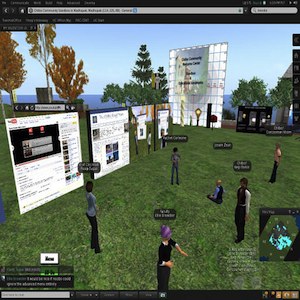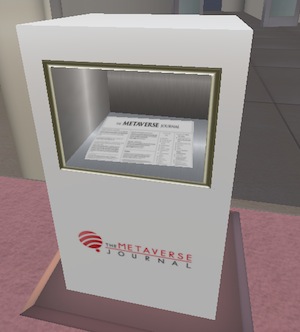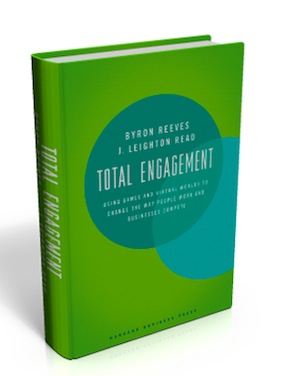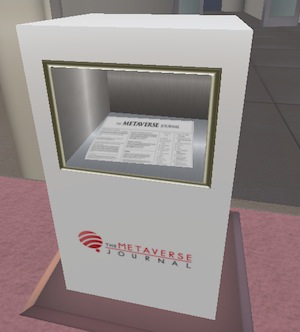1. Cypress Rosewood: Live in Second Life
2. Coco Latzo with Miron Batista
3. *SLAP* Second Life I See You
Tech -- Culture -- Humour
1. Cypress Rosewood: Live in Second Life
2. Coco Latzo with Miron Batista
3. *SLAP* Second Life I See You
 1. The University of Western Australia continues to by the dynamo of Australian Second Life presences, announcing a fourth sim, Virtlantis as well as announcing the February winners of its ongoing 3D Art and Design Challenge. A record 74 entries were submitted for the month. It’s hard to imagine a larger or more dynamic art installation in Second Life.
1. The University of Western Australia continues to by the dynamo of Australian Second Life presences, announcing a fourth sim, Virtlantis as well as announcing the February winners of its ongoing 3D Art and Design Challenge. A record 74 entries were submitted for the month. It’s hard to imagine a larger or more dynamic art installation in Second Life.
2. Linden Lab and John Lester (Pathfinder Linden) have parted ways – with lots of discussion ensuing on whether it’s part of a change in tack by Linden Lab in regards to dedicated resources for educators. In less reported news, Linden Lab’s General Manager Enterprise and expat Aussie Chris Collins finished up in February.
3. Got an iPhone or iPod Touch and haven’t noticed our bombardment of info on our new application? Read all about it here.
4. The US Army has announced the finalists in its virtual worlds challenge. It’s another example of the US Government’s fairly hefty commitment to exploring opportunities in virtual environments.
5. Pooky Amsterdam has a more extended machinima or her in-world interview with Holocaust survivor Fanny Starr. The three-plus minute intro could have been cut in half but this is a very interesting piece. A warning: it does contain graphic images of the Holocaust.
 I’m really pleased to be able to announce the availability of The Metaverse Reader, an iPhone application for virtual worlds residents / follower / interested parties.
I’m really pleased to be able to announce the availability of The Metaverse Reader, an iPhone application for virtual worlds residents / follower / interested parties.
You can download it here for free.
What is it?
It’s essentially an RSS reader with two sections. The first is our own RSS feed . The Second is a ‘Wider Metaverse’ section, which features a range of virtual worlds related feeds from around the world.
There’s only a handful at this stage but we’ll certainly be adding more – there’s been some issues with non RSS 2.0 feeds on some sites, which we’re working with the owners to rectify.
The ‘Submit a Story’ section is purely a contact form if you want to make contact.
Why wouldn’t I just use my RSS Reader?
For some, a broader RSS reader may indeed be preferable. However, we’ve had a lot of feedback that people like a quicker option of a handful of feeds easily accessed. The Metaverse Reader is exactly that. And at under 200KB in size, it’s also doesn’t take up much room.
Can I suggest a feed to add?
Absolutely – just contact us with the details.
Where do I get support for this app?
Are there plans to expand the app?
Version 2 is already underway – if you have suggestions for improvement, we’d love to hear from you.
What does the app cost?
Nothing 😉
Who developed the application?
I do need to give a huge plug to the developer who created the application from the specification provided. Phillip Street is an Australian iPhone developer and contributing writer who happens to live pretty close to me. I couldn’t be happier with his responsiveness and price competitiveness and I’ve already contracted him to work on the next version.
So if you have an iPhone, iPod Touch or have managed to be one of the world’s first iPad users, give the Metaverse Reader a whirl and critique away!
 It’s been a couple of weeks since Second Life’s Viewer 2.0 launched, and as always there’s been no shortage of comment. Gauging the balance is always a challenge, but I think it’s fair to say that overall the feedback has been overwhelmingly positive. The fly in the ointment has been the new search functionality, particularly its impact on live music events, with some musicians very frustrated at the setback although there doesn’t seem to be widespread concern.
It’s been a couple of weeks since Second Life’s Viewer 2.0 launched, and as always there’s been no shortage of comment. Gauging the balance is always a challenge, but I think it’s fair to say that overall the feedback has been overwhelmingly positive. The fly in the ointment has been the new search functionality, particularly its impact on live music events, with some musicians very frustrated at the setback although there doesn’t seem to be widespread concern.
For what it’s worth, I’ve found Viewer 2.0 has been a huge step forward, making me happier to log in each time. I’m not 100% sold on the new camera controls but that’s more an adjustment issue. Ron Blechner has a great summary of perceived improvements with his post 21 Reasons the New Second Life Viewer 2.0 is a Huge Improvement. Veteran SL resident Gwyneth Llewelyn has a brilliant tutorial for Mac users on optimising their Viewer 2.0 experience.
I’ve certainly been critical of Linden Lab over the years over updates that haven’t delivered or decisions that appeared short-sighted. With Viewer 2.0, it appears a more methodical approach to software development has paid off. It’s far from certain, and I’d suggest unlikely that Viewer 2.0 will drive more widespread adoption, but whether it does or not, it certainly appears to have made the majority of current users happier.
Over to you: do I have the rose-coloured glasses on or would you agree things have improved? I’d also love to hear from SL musicians who believe the search functionality has impeded their performance work.
Photo courtesy: Fleep Tuque
 1. The Australian (Australia) – Is putting real-life law into an avatar’s hands viable? “The difficult business of enforcing law and order in virtual worlds — and resolving the messy consequences when problems spill into real life — needs to be debated before knee-jerk political responses. Over the past fortnight Facebook memorial sites for murdered Queensland children Trinity Bates and Elliott Fletcher have been swamped by pornographic and obscene messages.”
1. The Australian (Australia) – Is putting real-life law into an avatar’s hands viable? “The difficult business of enforcing law and order in virtual worlds — and resolving the messy consequences when problems spill into real life — needs to be debated before knee-jerk political responses. Over the past fortnight Facebook memorial sites for murdered Queensland children Trinity Bates and Elliott Fletcher have been swamped by pornographic and obscene messages.”
2. CNET (USA) – Real-world woes shuttering virtual world There. “The pioneering virtual world There.com will shut down on March 9, a victim of the recession and the pinch on brand spending that had kept it going long past earlier troubles. The news was announced by CEO Mike Wilson on Tuesday.
The service, which launched in the fall of 2003, was a fully 3D social environment with a sophisticated economy, wonderful vehicles like hoverboard and hoverboats and, eventually, a wide variety of community-created content.”
3. Everything PR (Germany) – Real Baby Dies as Parents Raise Virtual Daughter. “When does virtual game play go to far? The parents of a starved baby may have found out, when their three-month old infant died of malnutrition. The South Korean couple left their baby to starve to death at home, while playing an internet game. The disturbing irony of it all? The web-based game they were playing involved the rearing of a virtual child.”
4. Radio National Future Tense (Australia) – Money – Part Two. “In part two of this series we look at the changing nature of currency. Is traditional state-issued tender now losing its monopoly? And how widespread is the use of alternative currencies – be they digital or virtual, or both?”
5. ZDNet (USA) – Earn 100 points – read: The reverse virutal reality world of the future. “Kevin Kelly, writing on his Technium blog points out a fascinating talk by Jesse Schell, a games designer. In “Design outside the box†Mr Schell starts by explaining out how much money is made by very simple games, such as Farmville and Club Penguin. But its the latter part of his talk that is even more interesting, when he predicts how games will be embedded into our reality through the use of cheap wireless sensors.”
6. Montreal Gazette (Canada) – ‘Avatars’ inspire us to be better people: study. “F ascination with the blockbuster 3-D film Avatar has fans tuning into real-world research indicating that virtual selves can inspire people to lead better lives. Since the release of the film, interest has surged in a Stanford University Virtual Human Interaction Lab study showing that avatars, animated versions of people, act as powerful role models. “It is getting so hot right now,” study author Jesse Fox told AFP on Thursday. “James Camerons’s Avatar movie is out so our website hits have just spiked.”
7. IT PRO (UK) – The chief executive of Second Life thinks virtual worlds will be the future of work. “Second Life is often assumed to be a place to go and kill a lot of time, where your alien-looking avatar wanders the landscape looking for virtual sex. The virtual world is much, much more than that, argues chief executive Mark Kingdon, who believes that people thought the internet was “weird” when it first started, too. At the CeBIT conference in Hanover this week, Kingdon told IT PRO that more business functions would move to worlds like Second Life, for meetings, simulations and more – especially after the launch of more user-friendly systems, like the beta of its new viewer, which allows document sharing.”
8. People Management Magazine (UK) – BP executives graduate on Second Life. “Thirty BP executives are to undergo a graduation ceremony on computer game and virtual network Second Life, after completing a programme at Manchester Business School (MBS). The Managing Projects programme will culminate in the executives using avatars to receive their awards on the business school’s “island” inside the virtual world on Thursday this week. Since those who completed the course are based as far afield as Canada, Angola, Indonesia and Russia, the online event is the best way of allowing them to celebrate their achievement together.”
9. Michigan Radio (USA) – “Inch-vesting” In Detroit: A Virtual Realty. “Jerry Paffendorf is not your typical real estate developer. But then, the people lining up to buy into his project are not your typical investors. He calls them “inchvestors.” Paffendorf’s project is called Loveland. And it’s a hybrid: part virtual and part physical. “What we want to do is we want to build this wild social network of people that’s literally built out of the dirt and the ground,” Paffendorf says.”
10. mad.co.uk (UK) – Social Gaming. “Social gaming is growing fast and brands are eyeing it with increasing interest. But how can they integrate themselves into gameplaying in a way that looks natural to users? With Zynga’s FarmVille now exceeding 76m monthly active users on Facebook and Playfish’s Pet Society exceeding 1m, growth in social gaming has well and truly taken off, a boom further illustrated by gaming giant Electronic Arts’ (EA) recent acquisition of Playfish in a deal potentially worth $400m (£268m). Zynga CEO Mark Pincus predicts that by 2012 there’ll be 500m people involved in social games, which means the opportunities for brands to get involved and reach this rapidly growing audience are also increasing.”
 This post appeared earlier this week over at Metaverse Health.
This post appeared earlier this week over at Metaverse Health.
It’s coming up to a year since we interviewed DeeAnna Nagel and Kate Anthony and discussed counselling in online environments broadly and in virtual environments more specifically. Over that time, the Online Therapy Institute has continued to grow. One example of this is the announcement of a five-hour course on online supervision.
Anyone who works in a counselling role will understand the importance of supervision as both a development and protective mechanism for a practitioner, let alone one working in an online environment. Additionally, a key plank of more widespread acceptance of online therapy is formalised governance mechanisms that provide peace of mind in regards to quality. Small steps like the ones taken here are helping to achieve just that.
The wider challenge is establishing e-health standards that ensure confidentiality, the ability to confirm practitioner credentials and good service navigation for face-to-face intervention when required. That sort of integration is potentially years off, but in the meantime counselling professionals are doing a great job of filling in the gaps.
If you’re involved in counselling in a virtual world environment, I’d love to hear from you to find out more about your work.
Update: an interview with the Online Therapy Institute in Second Life is now available:
 The news and events keep on coming thick and fast:
The news and events keep on coming thick and fast:
1. There.com has announced its imminent closure due to funding issues. It’s always sad to see a growing virtual world cease operation, particularly one that offered at least some level of content creation.
Frenzoo are offering lifetime VIP accounts to content creators on There.com. All the details here.
2. Two OpenSim grids have started using a virtual currency: the Open Metaverse Currency. More on that in coming days.
3. We still need more people to ask questions of our agony aunt, Second Lie. Here’s a sample of the life-threatening conundrums he’s solved to date.
4. Are you part of a couple or close friendship in a virtual world? Why not be the next subject of our V2 profiles? Just drop us a line if you’re interested. Here’s the first one published back in 2008.
5. The latest issue of the Journal of Virtual Worlds Research is now out. Guest editors are Australia’s own Mandy Salomon from Smart Services CRC, and France’s Serge Soudoplatoff from ESCP-EAP. The theme is Virtual Economies, Virtual Goods and Service Delivery in Virtual Worlds.
6. Twitter is getting further integration with Second Life. Linden Lab are also looking for people willing to have their RL and SL faces plastered on advertising.
 Byron Reeves is a Stanford University Professor and Co-Director of the Human Sciences and Technologies Advanced Research Institute. J. Leighton Read is a serial entrepreneur and CEO with an interest in the psychological aspects of gaming.
Byron Reeves is a Stanford University Professor and Co-Director of the Human Sciences and Technologies Advanced Research Institute. J. Leighton Read is a serial entrepreneur and CEO with an interest in the psychological aspects of gaming.
The premise of the book is the potential for games to become central in the workplace. It sounds a far-fetched premise initially, but that’s the power of the discussion put forward by the authors: they provide cogent, well-informed examples of how gaming within business could work. The focus is primarily MMOs, for a number of reasons, including:
1. They contain “the most counterstereotypical roster of players”, hence being the most worthwhile population from which to apply findings.
2. MMO players tend to have a higher level of engagement with their game and spend on average much more time per week than a solo gamer.
3. The dynamics of raids, quests etc tend to provide situations where teamwork and leadership can come to the fore.
After establishing its premise, the book goes on to provide some fascinating examples of work problems a gaming framework could solve, as well as some fairly detailed discussion around virtual teams, virtual leadership, virtual money and the link between play and work. There’s a useful summary at the end and a handful of tactics to actually start implementing some of the examples given. As the authors themselves say, one of the best tactics for any business is to harness the knowledge of the gamers in its midst.
Overall, this is a very engaging read with realistic, well thought out examples. For anyone interested in the applicability of virtual environments to the workplace, it’s a must-read. For the dedicated gamer who also happens to work for a large organisation, there’s also plenty of information to get you thinking about advocating for change.
The final world goes to one of the authors. Here’s a presentation from Byron Reeves on the topic of the book:
Byron Reeves – fbFund REV, 7/31/09 – Part 1 of 2 (Version 2), “Work Sucks – Games are great” from fbFund REV on Vimeo.
You can buy Total Engagement from our own bookshop, Amazon direct or a local online bookshop like Dymocks.
 1. CNET (USA) – Where virtual worlds once ruled, FarmVille dominates. “Almost every week for the last few years, it seems, I’ve gotten a press release or a pitch touting some company’s great new Facebook games network or kids’ virtual world.
1. CNET (USA) – Where virtual worlds once ruled, FarmVille dominates. “Almost every week for the last few years, it seems, I’ve gotten a press release or a pitch touting some company’s great new Facebook games network or kids’ virtual world.
And why not? Companies like Zynga and Playfish are making money hand over fist with their collections of massively popular social games, and 2D Flash games aimed at children like Club Penguin, Webkinz, Habbo Hotel, and others have garnered vast amounts of virtual world investment dollars in recent years.
But to someone who cut his virtual world teeth on more immersive, 3D environments like There and Second Life, these never-ending announcements of new companies trying to jump on the social gaming bandwagon have left me with one nagging question: Where is the innovation?”
2. Computerworld (USA) – Second Life seeks mainstream adoption. “Linden Lab, which develops and operates Second Life introduced a new beta version of its desktop viewer software on Tuesday, the first big upgrade in many years. Will the new software help bring about a renaissance of the once-trendy service? You remember Second Life. It’s a virtual world, a three-dimensional environment like World of Warcraft or Grand Theft Auto. But it’s not a game, it’s a simulation of a world. You can build virtual buildings and vehicles, create virtual clothes, play live music, role-play as a vampire or cowboy, and buy and sell virtual goods for real-world money. It’s the closest thing we have now to Star Trek’s holodeck.”
3. CLickZ (USA) – WildTangent Targets Social Media Games and Virtual Worlds. “Game-based advertising company WildTangent announced the launch of BrandBoost, a platform that enables brand marketers to tap into the audience for virtual worlds, social media games, and massively multiplayer online games. The Redmond, WA-based company said BrandBoost is already being deployed on several properties, including OutSpark.com, OMGPOP.com and Sony Online Entertainment’s FreeRealms, which already has attracted 8 million registered users since its formal launch last year.”
4. Hypergrid Business (Hong Kong) – Virtual worlds pose compliance risks. “The very aspects of virtual world that make them appealing to some enterprise users, such as the collaboration tools, also make them risky from a compliance perspective. These risks include the communication risks of the wrong information getting to the wrong people, inappropriate workplace behavior, and lack of archiving tools.”
5. Los Angeles Times (USA) – Disney hopes kids will take online World of Cars out for a spin. “Walt Disney Co. believes that World of Cars, its new subscription-based online community aimed at boys and based on the Pixar movie “Cars,” won’t get lost in the traffic of virtual worlds. Things are already a bit congested. Some 200 virtual worlds target children under 12. Each competes for a slice of the 10 hours and 45 minutes a day the Kaiser Family Foundation estimates that kids spend viewing media, simultaneously vying for screen time against a growing number of portable media players and smart phones that offer their own diversions.”
6. Escapist Magazine (USA) – Are Advertisers Running Away From Home? “The failure of PlayStation Home to capture gamers’ attention may be having repercussions as advertisers jump ship to the more media-friendly Xbox Live. When PlayStation Home made its open beta debut at the tail end of 2008, gamers responded with a collective shrug of disinterest. The world had barely any of the content originally promised, felt empty and lifeless, and offered little incentive to log in more than once. Home’s failure to connect with users may be the reason for Sony’s absence from this year’s Engage Expo, believe brand analysts at Brand Week, when the hardware giant had been promoting the service as the next big thing at the Expo just a year before.”
7. Stanford Report (USA) – Can avatars change the way we think and act? “If you saw a digital image of yourself running on a virtual treadmill, would you feel like going to the gym? Probably so, according to a Stanford study showing that personalized avatars can motivate people to exercise and eat right. Moreover, you are more likely to imitate the behavior of an avatar in real life if it looks like you, said Jesse Fox, a doctoral candidate in the Communication Department and a researcher at the Stanford Virtual Human Interaction Lab. In her study, she used digital photographs of participants to create personalized avatar bodies, a service some game companies offer today.”
8. FierceContentManagement (USA) – What if content management were 3D? “I recently saw the Michael Douglas/Demi Moore 1994 movie called “Disclosure.” In the movie (which explores sexual harassment in the workplace), Michael Douglas was working for a computer company that created a 3D virtual reality database. The user would put on special glasses and he was literally inside the database with the data. He could walk inside a library of content, interact with it and touch it.”
9. Sydney Morning Herald (Australia) – No R-rating for games does not compute. “It’s confession time. I have picked up a prostitute in a stolen vehicle and sped the wrong way down a busy highway to escape police. I have accompanied a terrorist group in an airport shooting spree. I have garrotted guards, slaughtered soldiers, decapitated dudes and shotgunned sheilas. But never have I felt the remotest desire to do any of this for real. They were computer games. Yes, I’m a ”gamer”. At 37, I’m a little older than average for a gamer, but not by much. Gen X was the first gaming generation. I can’t remember there not being computer games. I first discovered there wasn’t a Father Christmas when I found a (very primitive) computer game under my parents’ bed, and got it as a present a few days later.”
10. USA Today (USA) – Author: Librarian, cybrarian appreciation is ‘Overdue’. “Bryan Hissong is 31, happily married, and the father of a 2-year-old named Olivia. He seems quite content with his life.
But Marilyn Johnson, who is not his wife, loves him and has said so very publicly. It doesn’t matter that she has never met him. Hissong is a librarian. He doesn’t look like the clichéd librarian of old. He favors plaid shirts and is sporting a beard on his babyface — but that doesn’t matter to Johnson, either. She’s well aware that librarians wear many disguises these days. Often they’re pierced, tattooed, punk with bright blue hair. She loves them all.”
1. DESTRUCCION
2. Second Life Ms Too Sexy & Ms Valentines Top 10 Featuring Ms Hot Beach 2010
3. Second Life Funny Moments #2 (2009)
Copyright © 2024 · Magazine Child Theme on Genesis Framework · WordPress · Log in
Recent Comments